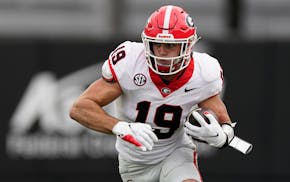If you want a great example of the difference between a large sample size and a small one, look no further than a recent ESPN.com project using its "Football Power Index" simulations.
Running 20,000 simulations of the 2019 season, the FPI finds that the NFC North is essentially a three-way toss-up between the Vikings, Bears and Packers. All three are projected to win between 8.6 and 8.8 games, with all three projected among the top 10 NFL teams and the Vikings given the slightest of slight edges over the other two.
But ESPN also isolated on one specific simulation – No. 1,721, according to the web site – to project outcomes for all 267 games in the season for the entire NFL. In that one simulation, the Vikings lost 27-13 to the Falcons in Week 1 and went just 7-9 for the season while the Bears went 8-7-1. The Packers dominated the NFC North, going 13-3.
Vikings fans are hoping for any of the other 19,999 potential realities, I would imagine (though it should be noted the Packers at least were bounced from the playoffs).
These differences in scale, though – one vs. 20,000 – are fascinating when placed side by side.
And picking just one out of 20,000 reveals a haunting but marvelous truth about sports: The season that eventually actually does happen doesn't necessarily most accurately reflect the composite strengths and weaknesses of teams.
It's a snap shot of randomness, fortunate bounces, magnificent performances and being in the right place at the right time (or wrong place at the wrong time).
But you can't play the 2019 season 20,000 times in real life (though the NFL owners might love to try to add it to the new collective bargaining agreement to goose TV revenue). Only one season can become reality.
The random nature of that reality is particularly true of the NFL, where the 16-game regular season leaves little margin for error between a 10-6 playoff team and a 6-10 team that might get a coach fired.
There is relatively little actual scoring in football, its tallies inflated by the values of touchdowns and field goals. (Maybe if soccer awarded anywhere between 6 and 8 points for a goal, it would catch on faster here).
Major League Baseball has 10 times as many games, the NBA and NHL five times as many. You can recover from one loss in those sports. In the NFL? The accuracy of one kick can have put a major dent in a season.
And so maybe your initial reaction to seeing simulation 1,721 is to scoff. If those three teams in the NFC North are so bunched together, how can one jump so far ahead? (And the Packers, no less).
But arriving at an average of between 8.6 and 8.8 wins, as the Vikings, Packers and Bears are projected to have, doesn't mean a bunch of exclusively eight- and nine-win seasons. Those are probably most likely, followed by 10- and seven-win seasons, but the outliers – especially in the volatile NFL – matter.
In the Packers' 20,000 simulations, we already know there's a 13-win season. There's probably a 3-13 season in there, too. Same goes for the Vikings and Bears. Those high-end possibilities are seductive and part of the NFL's particular charm. It's much harder to imagine a slightly above-average (on paper) team in, say, the NBA rising up to claim the league's best record.
In the NFL, there's not always enough time for things to even out. Win a few games you weren't supposed to win, and a charmed season could be yours. Lose a couple the other way, and it's hard to catch up.
As interesting as these simulations might seem, though, it will be nice to finally play the real games. The NFL season opens Thursday night, of course, with the Packers at the Bears. Week 1 of simulation 1,721 says Packers 34, Bears 27.
That's just a one-touchdown difference – enough for one bounce to disrupt the whole thing.
And maybe, just maybe, simulation 1,722 has the Vikings winning the Super Bowl.
Chinese Grand Prix could deliver drama to F1 and slow Verstappen's victory march
Rivalries on tap with Barcelona-Chelsea and Lyon-PSG in Women's Champions League semifinals

